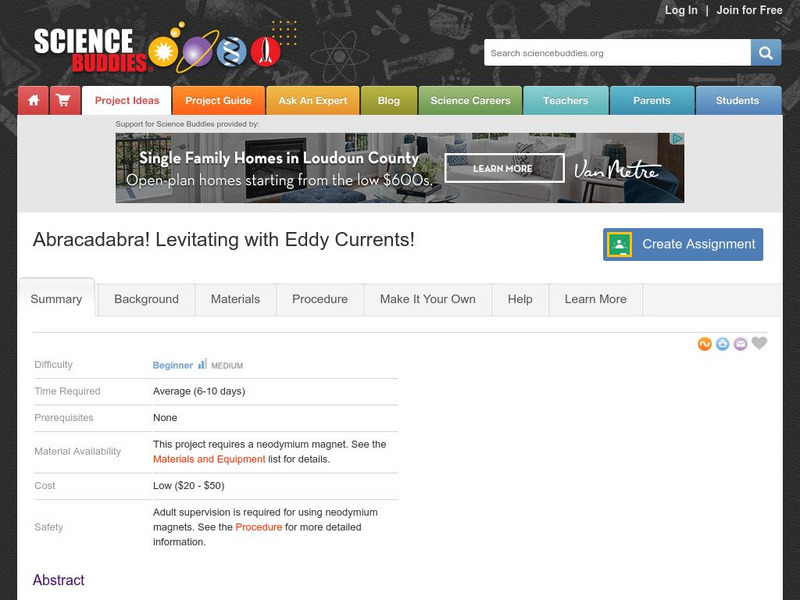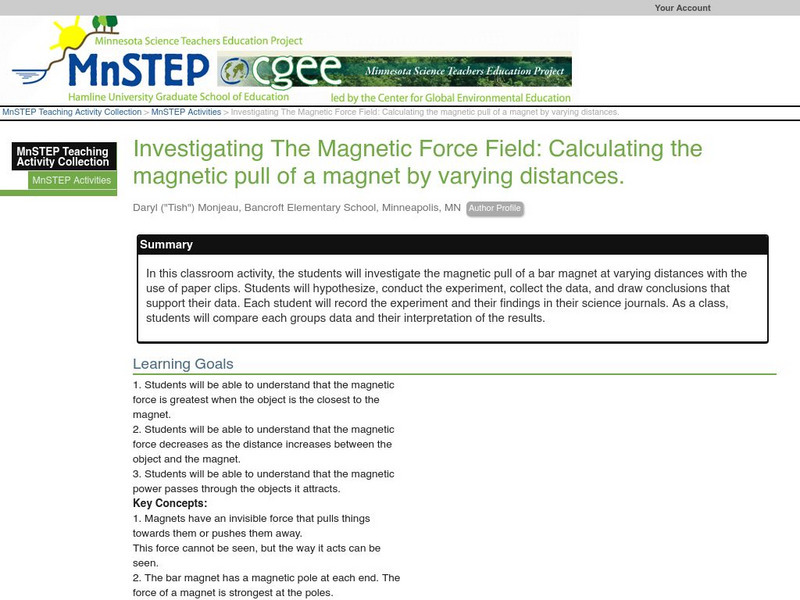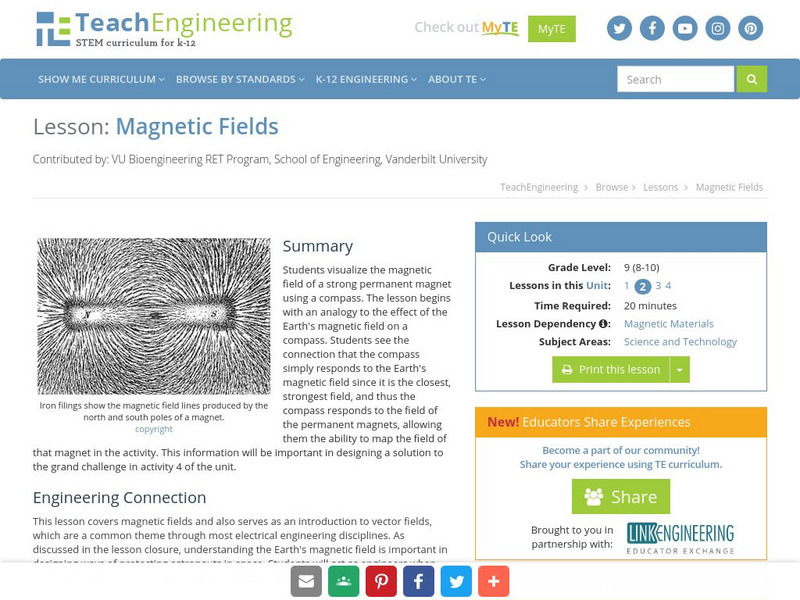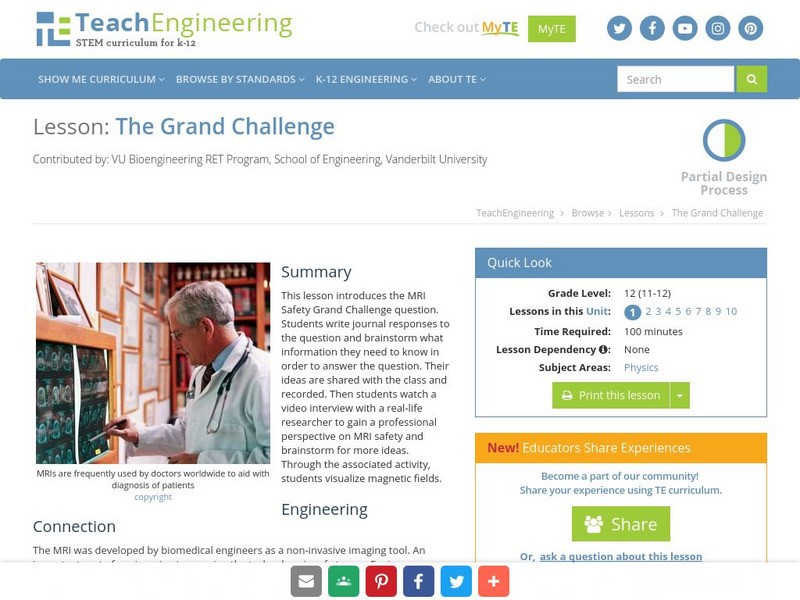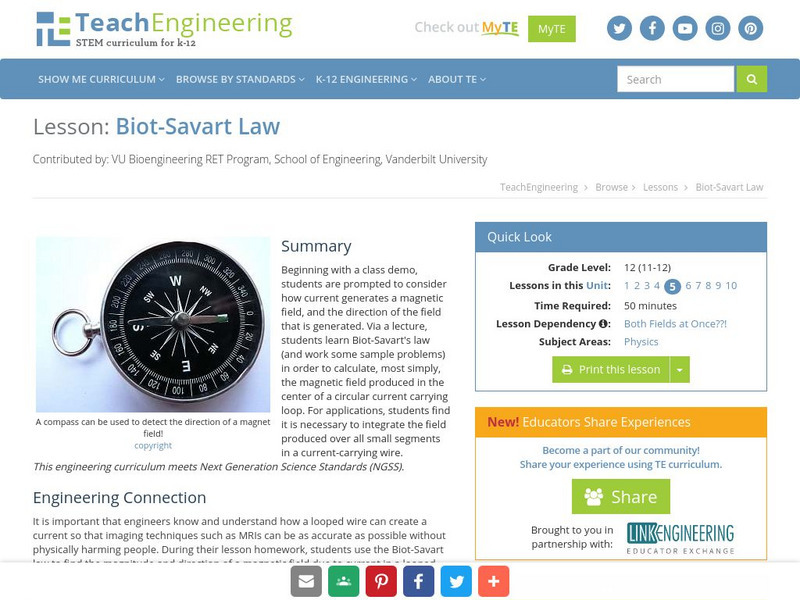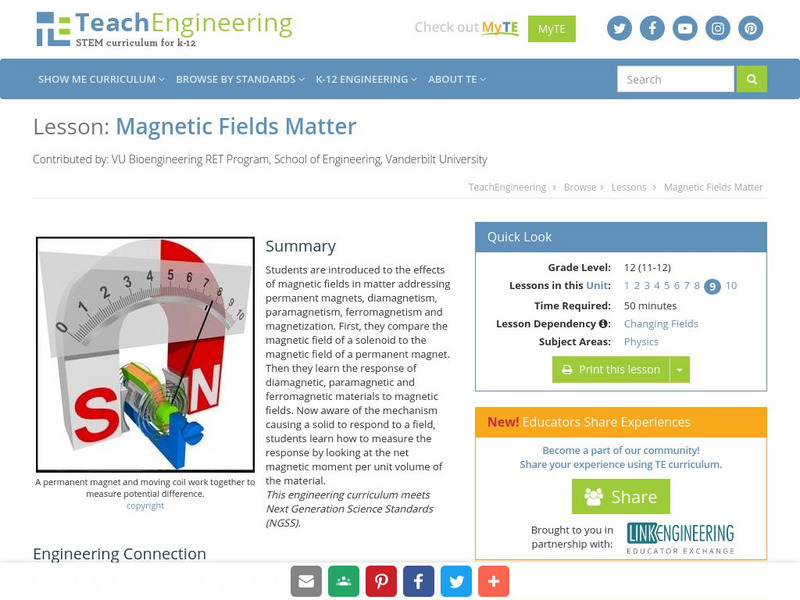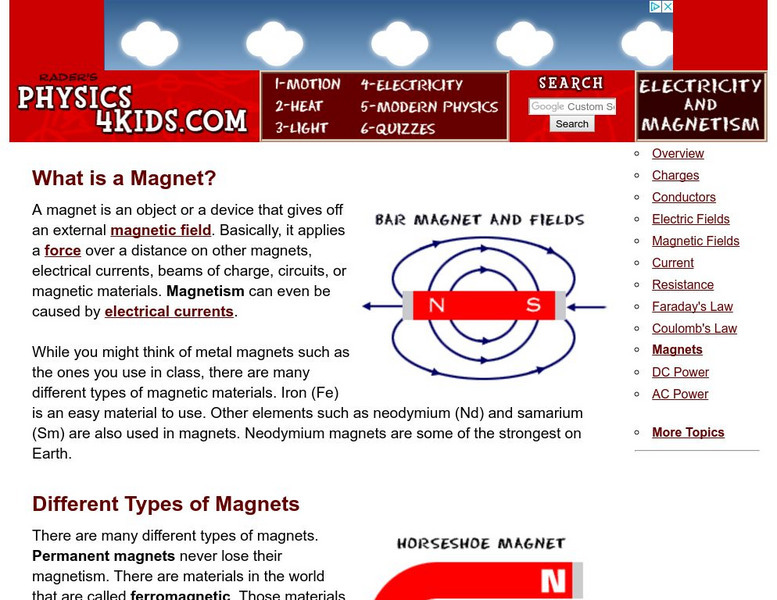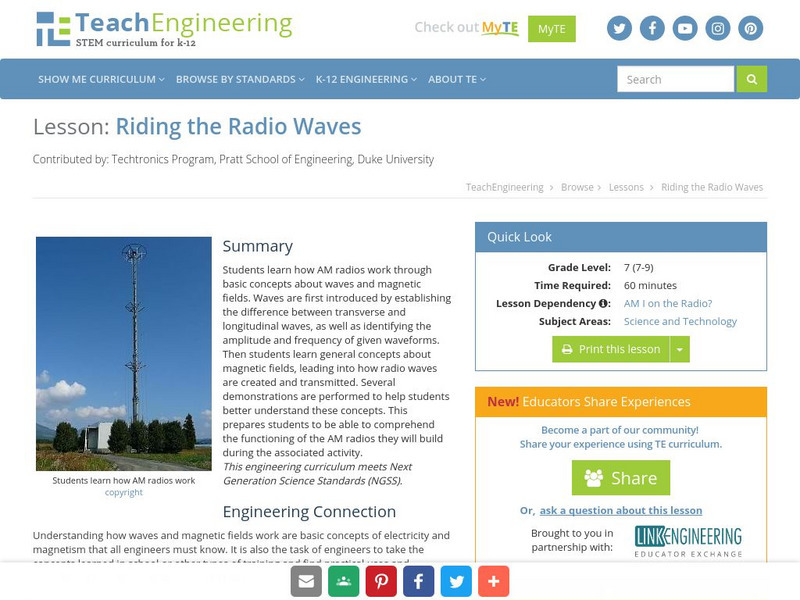Hi, what do you want to do?
Science Buddies
Science Buddies: How the Strength of a Magnet Varies With Temperature
Physicists sometimes study matter under extreme conditions. For example, think of the emptiness of interstellar space vs. the unimaginable crush of pressure at the center of a neutron star, or an object dipped in liquid nitrogen vs. the...
Science Buddies
Science Buddies: Abracadabra! Levitating With Eddy Currents!
Did you know that not all trains run on tracks? Some of the world's fastest trains are magnetic levitation trains (maglev). This means that the carriage of the train is suspended over the rails with no support, but only with magnetic...
Science Education Resource Center at Carleton College
Serc: Investigating the Magnetic Force Field: Calculating Magnetic Pull
In this classroom activity, the young scholars will investigate the magnetic pull of a bar magnet at varying distances with the use of paper clips. Students will hypothesize, conduct the experiment, collect the data, and draw conclusions...
American Association of Physics Teachers
Com Padre Digital Library: Open Source Physics: Magnetic Bar Field Model
A bar magnet model built by placing a group of magnetic dipoles along the magnet. This simulation shows the magnetic field of a bar magnet, and has a movable compass which shows the magnetic field values.
TeachEngineering
Teach Engineering: Drawing Magnetic Fields
Students use a compass and a permanent magnet to trace the magnetic field lines produced by the magnet. By positioning the compass in enough spots around the magnet, the overall magnet field will be evident from the collection of arrows...
TeachEngineering
Teach Engineering: Visualizing Magnetic Field Lines
In this activity, students take the age old concept of etch-a-sketch a step further. Using iron filings, students begin visualizing magnetic field lines. To do so, students use a compass to read the direction of the magnet's magnetic...
TeachEngineering
Teach Engineering: Magnetic Fields
Students visualize the magnetic field of a strong permanent magnet using a compass. The lesson begins with an analogy to the effect of the Earth's magnetic field on a compass. Students see the connection that the compass simply responds...
TeachEngineering
Teach Engineering: The Grand Challenge
This lesson introduces the MRI Safety Grand Challenge question. Young scholars are asked to write journal responses to the question and brainstorm what information they will need to answer the question. The ideas are shared with the...
TeachEngineering
Teach Engineering: May the Magnetic Force Be With You
This lesson begins with a demonstration of the deflection of an electron beam. Young scholars then review their knowledge of the cross product and the right hand rule with sample problems. After which, students study the magnetic force...
TeachEngineering
Teach Engineering: Thrown for a Loop
In this lesson, students begin to focus on the torque associated with a current carrying loop in a magnetic field. Students are prompted with example problems and use diagrams to visualize the vector product. In addition, students learn...
TeachEngineering
Teach Engineering: Biot Savart Law
This lesson begins with a demonstration prompting students to consider how current generates a magnetic field and the direction of the field that is generated. Through formal lecture, students learn Biot-Savart's law in order to...
TeachEngineering
Teach Engineering: Changing Fields
This lesson begins with an activity in which students induce EMF in a coil of wire using magnetic fields. Then, demonstrations on Eddy currents show how a magnetic field can slow magnets just as Eddy currents are used to slow large...
TeachEngineering
Teach Engineering: Magnetic Fields Matter
This lesson introduces students to the effects of magnetic fields in matter addressing permanent magnets, diamagnetism, paramagnetism, ferromagnetism, and magnetization. First students must compare the magnetic field of a solenoid to the...
Physics4kids
Physics4kids: Electricity and Magnetism: Magnets
Here is the site to help you learn all about magnetism and magnets! Find out what a magnet is and how it works. Click for additional details on charges, conductors, magnetic fields, currents, resistance as well as the Laws of Faraday and...
Other
Physics.org: Frogs Levitate in a Strong Enough Magnetic Field
Captivating information about how frogs can levitate in magnetic fields. Easy to understand, it also explains how the Earth's magnetic field is produced.
TeachEngineering
Teach Engineering: Riding the Radio Waves
In this lesson students learn how AM radios work through basic concepts about waves and magnetic fields. Waves are first introduced by establishing the difference between transverse and longitudinal waves, as well as identifying the...
University Corporation for Atmospheric Research
Ucar: The Sun Earth Connection: Exploring the Dynamic Nature of the Sun
The unit contains lessons and a presentation that allow students to explore the Sun through images and investigate how magnetism from the Sun interacts with the Earth's magnetic field during space weather events.
OpenSciEd
Open Sci Ed: 8.3 Forces at a Distance
This unit allows students to investigate the cause of a speaker's vibration in addition to the effect.
University Corporation for Atmospheric Research
Ucar: The Sun Earth Connection: The Magnetic Sun
Young scholars will build a simple version of a magnetometer and use it to discover the types of areas of the Sun that have very strong magnetic fields. Students will then describe what the types of features associated with the Sun's...
Open Ed
Open Ed Sci: 8.3 Forces at a Distance
This unit launches with a slow-motion video of a speaker as it plays music. In the previous unit, students developed a model of sound. This unit allows students to investigate the cause of a speaker's vibration in addition to the effect.
Massachusetts Institute of Technology
Mit: Open Course Ware: Forces: Current Carrying Wires in Magnetic Fields
Learners investigate current-carrying wires in magnetic fields. Some topics explored in the activities are forces, magnetic dipoles, and circuits. The resource consists of video clips, lecture notes, exam questions, java applets, and...
Cosmos 4 kids
Cosmos4 kids.com: Solar System Details
This comprehensive site delves into other aspects of our solar system besides the planets and the sun. Click on the topics on the right like solar winds, the heliosphere, the heliopause, asteroids, comets, and more.
Exploratorium
Exploratorium: Auroras Paintings in the Sky
This site offers a very nice, detailed explanation of auroras along with some inspiring images and videos.
Georgia State University
Georgia State University: Hyper Physics: Magnetic Properties of Solids
This site from the Georgia State University contains a good overview of some of the magnetic properties that are common to all materials, such as susceptibility and permeability, and then specific discussion of both diamagnetic and...






